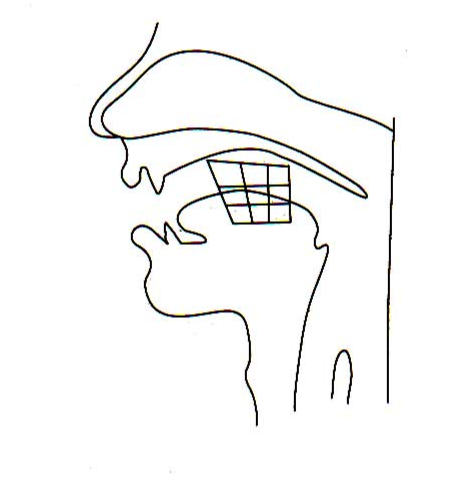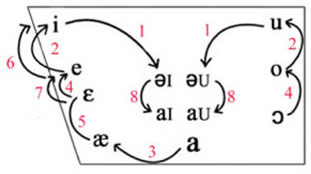|

|
English Structures
Historical Linguistics: The History of English
|
Modern English
The third period of English is the Modern English period. The Modern English period begins around 1500 and continues to the present. That is, what we speak today is Modern English, and it is essentially the same as what was spoken in the 1500s.
You don't believe it? Let's look at some examples of works written in that early Modern English period.
Activity: Looking at Early Modern English
Look at the excerpt from Shakespeare's play Julius Caesar. Try to find a word that you don't know in it. Try to reword it as if you were speaking it today. How many changes would you need to make?
Friends, Romans, countrymen, lend me your ears;
I come to bury Caesar, not to praise him.
The evil that men do lives after them;
The good is oft interred with their bones;
So let it be with Caesar. The noble Brutus
Hath told you Caesar was ambitious:
If it were so, it was a grievous fault,
And grievously hath Caesar answer'd it.
Now do the same with an excerpt of the Canterbury Tales of almost the same length. First, find the words you don't know. Next, try to reword it as if you were saying it today. How many changes would you need to make?
Now preye I to hem alle that herkne this litel tretys or rede, that if ther be any thynge in it that liketh hem, that therof they thanken oure lord Jhesu Crist, of whom procedeth al wit and al goodnesse. And if ther be any thyng that displese hem, I preye hem also that they arrette it to the defaute of myn unkonnynge, and nat to my wyl, that wolde ful fayn have seyd bettre if I hadde had konnynge.
Which of the two is close to the English we use today? Is either of them exactly the same?
We know that the invasion of England by William the Conqueror created the break between Old English and Middle English, but what separates Middle and Modern English?
A phenomenon called the Great Vowel Shift. |
The Great Vowel Shift |
The Great Vowel Shift is a chain reaction that
altered the pronunciation of the long vowels of Middle English. In this process of language change, almost every word of Middle English with a long vowel in it received a new pronunciation. The whole vowel system was thus radically affected, and when an entire language system is altered, it is not unreasonable to see it as entering a new period.
By the way, English isn’t the only language that had a great vowel shift. Chinese did too.
In order to understand the Great Vowel Shift, it is necessary to understand a bit of phonetics, especially how vowels are articulated, or produced, in the vocal tract.
Linguistic Notes: The Articulation of Vowels
|
|
When we produce langauge sounds, we move the various parts of the vocal tract, including the tongue and the vocal cords (the vocal folds). Each langauge sound is described (named actually) by which parts of the vocal tract are used. Vowels are described by naming which part of the tongue is used, how high the tongue is lifted in the mouth, and by the shape of the lips.
For example, the vowel in the word see is made by using the front part of the tongue, lifting it high up, close to the roof of the mouth, and keeping the lips spread kind of like in a smile. It is named the high front, unround vowel, as a result.
In contrast, the vowel in the word do is made by using the back of the tongue and raising it high, close to the roof of the mouth, and rounding the lips, kind of like when making a kiss. It is named the high back, rounded vowel.
The vowel system of a language identifies each vowel in the language and names it according to these features. In addition, modifications to a vowel can be added to the name, and so we can add whether a vowel is long or short, too. Middle English had both a long high front, unround vowel and a short high front unround vowel. It had both long and short versions of almost all the vowels. In the Great Vowel Shift, the long high front, unround vowel changed in pronunciation, but the short high front didn't.
Vowel Articulation
Note the tongue parts and height positions in relation to the chart diagram shape
- The left side of the chart shows the front part of the tongue
- The right side of the chart shows the back part of the tongue
- The top of the chart shows vowels made by raising the tongue (and closing the mouth)
- The bottom of the chart shows vowels made by lowering the tongue (usually by opening the mouth more)
http://en.wikipedia.org/wiki/Image:Britain_500_CE.png |


|
|
|
Vowel Shifts |
Definition
|
A vowel shift occurs when the ways of pronouncing vowels in a language change. |
|
Types of Shifts
|
If people begin pronouncing certain vowels by raising the tongue more than before or closing the mouth more, there is a shift of vowel raising.
If people begin pronouncing certain vowels by opening the mouth more or lowering the tongue, then the shift consists of vowel lowering. |
|
Direction of Movement and Starting Points There are three possible starting points for a shift,
each creating a type of chain reaction named after the direction of movement caused by the starting point of the shift. |
|
1. Drag Chain.
A high vowel can change to a diphthong (by becoming more centralized) leaving an open spot that the next highest vowel got dragged into.
| 2. Push Chain.
A low vowel can crowd the next highest one, pushing
it up to crowd the next one and so on. The high vowels would have to become more centralized or diphthongized or change into a consonant. |
3. Push-Drag Chain.
One of the mid vowels can change first. Then there would have been both pushing and dragging, creating a Push-Drag Chain
|

|
|
|
The Great Vowel Shift in English
The Great Vowel Shift in English was a drag chain that resulted in vowel raising.
- The long high vowels changed first in pronunciation to diphthongs.
- They dragged the other long vowels behind them.
- Words that used to a long vowel changed and were pronounced with a vowel in a higher tongue position
- the shift was one of vowel raising.
|
- 1: /i/ and /u/ diphthongize and become /əɪ/ and /əU/
- 2: /e/ and /o/ move up to become /i/ and /u/
- 3: /a/ moves up to /æ/
- 4: /ε/ becomes /e/, /ɔ/ becomes /o/
- 5: /æ/ moves up to /ε/
- 6: /e/ moves up to /i/
- 7: /ε/ moves up to /e/; The new /ε/ created in Step 5 now moves up.
- 8: /əɪ/ and /əu/ shift to /aɪ/ and /aU/.
|
 |
|
| All the shifting, after a few generations of changes (The w holeprocess took about 200 years.), results in the Modern English vowel chart. |
 |
|
The Great Vowel shift accounts for why English pronounces many of the same spellings different ways:
- [aj] hi
- [i] he�
- [I] hit
- [e] hay
- [ɛ] hell
- [æ] hat
We can see that the letter ‘i’ corresponds to
both 1 and 3; ‘e’ corresponds to 2 and 5; ‘a’ corresponds
to 4 and 6.
http://asstudents.unco.edu/faculty/tbredehoft/UNCclasses/ENG419/GVS.html |
When students ask why a letter is pronounced one way in
one word and another way in another word, you now know the answer:
In history, the spelling originally matched the pronunciation,
but for some reason when the pronunciation changed, the spelling
didn’t.
|
But what caused the Great Vowel Shift?
No one knows for sure!
None of the usual causes of language change seem to have occurred during
that time period
What are the usual causes of language change? |
| Continue
with Part 5 |
|
American Sign Language The sign language used by the deaf community in the United States.
Test of English for International Communication. A standardized exam for Educational Testing Services that is intended to determine the general capability of an NNSE to use English to conduct business. It is used by some businesses, predominantly in Asia, in hiring.
Test of English as a Foreign Language. A standardized exam from Educational Testing Services that is intended to determine the general capability of an NNSE to use English as the language of insruction .It is used as an admissions requirement by most US universities and colleges for international students.
Teaching English to Speakers of Other Languages. A term that encompasses both TEFL and TESL. It is the name of the professional organization to which many teachers belong. TESOL the organization has many regional affiliates both in the US and abroad.
Teaching English as Second Language. Refers to the activity of teaching the English language as a tool necessary for some daily task like instruction, shopping, or interpersonal interactions.
Teaching English as a Foreign Language. Refers to the activity of teaching the English language as an intellectual, academic pursuit to non-native speakers of English.
Native Speaker of English. Refers to a person who acquired English in infancy and young childhood as a first language.
Native Speaker. Refers to a person whose relationship to a language is that it was encountered in infancy and young childhood as the dominant language of the environment.
Non-Native Speaker of English. Refers to a person who didn't acquire English as a first language, but came to it after another language was established.
Non-Native Speaker. Refers to a person whose relationship to a particular language is that he/she didn't encounter it while initially acquiring language, but came to it after another language was established.
Limited English Proficient. An adjectival phrase used to refer to the same students as ELL refers to. LEP is falling into disuse as it focuses attention on student deficiency rather than on the positive attribute of learning. Is being replaced by ELL.
Second Language. Refers to any language gained subsequent to the first or native language. It is acquired or learned secondarily to the native language. Doesn't refer to the ordinal numbering of languages, only to the relationship of a particular language to a persons native language.
First Language. Refers to the language that an individual encounters as an infant and young child; a persons native language.
English for Specific Purposes. Refers to the goal of learning English to use it for highly focused activity, such as for business or for aviation communication.
English as a Second Language Program. refers to a school program that is purposefully structured to provide instruction on the English language to NNSEs. An ESL program does not typically include instruction in any other subjects than English. An ESL program may be a component of a larger ELL program at a school.
English as a Second Language. Refers to the subject matter of the English language and the methodology for teaching the English language to non-native speakers. ESL makes no reference to the subjects other than English, but it is not methodology alone either, it refers to teaching the English language as content area. Typically, ESL refers to the study of English in a country where it is used for at least one daily task, such as instruction, interpersonal relations, or shopping.
English Langauge Learner Program. Refers to a school program that is purposly structured to provide instruction on the English language and instruction in other content areas to English Language Learners.
English Language Learner. Refers to students who are in the process of learning English, whether they are in ESL classes exclusively or a combination of ESL classes and other subject area classes.
English as a Foreign Langauge. Refers to the study of English as an intellectual, academic pursuit, not a a language whose use is necessary or desirable for daily life, although it may be used as a research tool. Typically, EFL is the study of English in a country where English is not a language of instruction or daily interactions, such as in Italy or in Saudi Arabia.
English for Academic Purposes. Refers to the goal of learning English to use it as the language of instruction for other subject areas.
Refers to a school program that is purposely structured so that students will use two languages on a daily basis.
Refers to the use of two languages in any capacity on a daily basis. A bilingual person uses two languages on a daily basis--for work and at home, perhaps, or for different subjects at school. Can also refer to the ability to use two languages, even if not used daily.